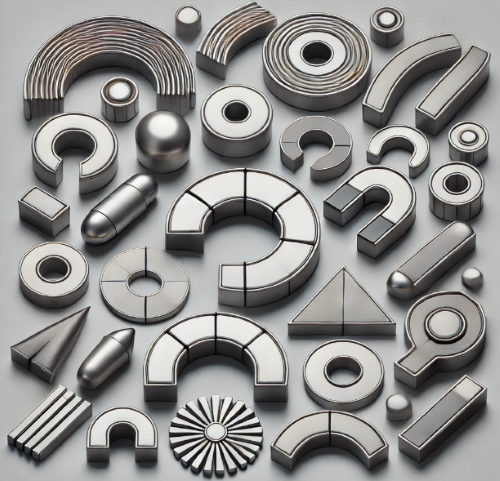Custom Magnet Manufacturing: From Drawings to Profiles
Introduction
In the modern manufacturing industry, custom magnets are crucial for driving technological advancements. Stanford Magnets, with its extensive experience and expertise, offers a comprehensive custom magnet service, covering every step from design to production of the final magnet profiles. This article will delve into its custom magnet manufacturing process with a specific case.

Custom Magnet Manufacturing Process
Stanford Magnets’ custom magnet manufacturing process is designed to meet specific customer needs, from initial design to finished products. Below are the key steps involved:
1. Design and Drawing Generation
The process starts with customer requirements, where our engineering team collaborates closely with the client to create detailed drawings based on application needs, performance requirements, and environmental conditions. These designs can cover:
– Geometric shapes: Circular, square, arc-shaped, or complex custom shapes.
– Magnetic properties: Including magnetic strength, field direction, and operating temperature.
– Material selection: Common materials include neodymium (NdFeB), samarium cobalt (SmCo), alnico, and ferrite.
2. Material Selection
Material choice is crucial as it determines the magnet’s final performance. Based on the application, we offer high-performance magnetic materials, such as SmCo for high-temperature environments or NdFeB for high-efficiency motors. Each material is selected for its magnetic, corrosion resistance, and mechanical strength, ensuring optimal performance in real-world use.
3. Prototype Production and Testing
Once the drawings are confirmed, Stanford Magnets produces a prototype and conducts rigorous testing to ensure the custom magnet meets all design specifications. Common tests include:
– Magnetic performance testing: Measuring the magnetic field strength and stability.
– Thermal resistance testing: Evaluating how the magnet’s properties change with temperature.
– Corrosion resistance testing: Especially important for magnets used in humid or chemical environments.
4. Production and Profile Machining
We use advanced manufacturing techniques such as sintering, pressing, and injection molding to produce the required magnet profiles. This includes simple geometric shapes to complex 3D structures, all while ensuring precision and consistency. We also offer surface treatments like zinc plating, nickel plating, and PTFE coatings to enhance the magnet’s durability.
Related reading: Manufacturing Methods of Permanent Magnets
Case Study: Custom Neodymium Magnets for Electric Vehicle Motors
1. Customer Requirement
A leading electric vehicle (EV) manufacturer approached Stanford Magnets to design a custom neodymium magnet for their next-generation high-efficiency motor. The goals were to enhance motor power density and reduce energy loss. The customer required the magnet to meet the following conditions:
– High magnetic strength: For the rotor section of the motor, requiring maximum magnetic field effect.
– High-temperature resistance: The motor operates at temperatures exceeding 150°C, so the magnet must maintain its magnetism at high temperatures.
– Complex geometric shape: The customer requested a custom arc-shaped magnet to reduce energy loss in the motor.
2. Solution and Implementation
- Design Stage
Our engineering team collaborated with the client to finalize detailed designs using CAD software, creating 3D models of the magnet with an arc-shaped structure and precise magnetic field distribution. The designs were reviewed and approved by the client with some adjustments.
- Material Selection and Prototype Testing
We recommended high-temperature neodymium alloy (NdFeB-H) for this project, known for its strong magnetic properties and corrosion resistance at elevated temperatures. Once the prototype was created, it underwent several rounds of performance testing, including magnetic strength and thermal testing, to ensure minimal magnetism loss (<5%) at 150°C.
- Profile Production and Machining
After the prototype was validated, we moved to mass production using precision machining techniques to create the arc-shaped magnets tailored for the motor’s rotor structure. Using advanced molding processes, the magnets’ geometric tolerances were controlled within ±0.01mm, ensuring a perfect fit in the rotor, optimizing energy efficiency.
- Surface Treatment and Delivery
To improve the magnet’s durability, we applied nickel plating, enhancing its resistance to corrosion. The custom neodymium magnets were then subjected to quality control procedures and delivered to the customer for use in large-scale EV motor production.
3. Results and Customer Feedback
After implementing the custom neodymium magnets in their EV motors, the customer reported a 20% increase in power density while reducing energy losses, significantly improving overall efficiency. The custom solution not only enhanced the product’s competitiveness but also reduced long-term maintenance costs.
Conclusion
Through its flexible design capabilities, advanced material selection, and precision machining technology, Stanford Magnets provides custom magnet solutions from concept to finished profiles. Whether for high-efficiency motors, aerospace equipment, or industrial applications, our custom magnet services are designed to meet the most demanding requirements. As industries evolve, we will continue innovating the magnet customization processes to address the changing needs of the market. For more magnets customization, please visit Stanford Magnets.